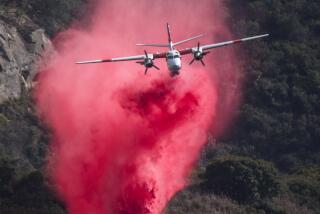Riding High : 100-Mile Commute Is a Quick, Low-Stress Trip--If You’re in a Light-Plane Pool
Derek Jury usually gulps down a cup of coffee on the ride to work, then curls up in the back seat for a short nap.
It has to be a short one, because the 100-mile trip from Murrieta, where he lives, to Hawthorne, where he works, takes only about half an hour. And that’s only one of the advantages of commuting to work in a light plane.
“Sure, we save a lot of time,” said Bryan Adams, another member of the commuting pool. “But the biggest thing we save is stress.”
“It’s not having to be on the freeways, with all those hang-ups, not having to worry about the hassle of driving,” Jury said. “It makes living out where we live possible.”
Jury, Adams and John Bramlett, pilot and owner of the single-engine, four-seat Cessna they fly in, live in the rural Riverside County community of Murrieta, about midway between Temecula and Lake Elsinore. Ron Palmer, the fourth member of the pool, lives in Menifee, up I-215 a bit, near Sun City.
“It’s wonderful out there,” Jury said. “Horse ranches, vineyards . . . “
But Jury said that the drive to his job at Hughes Aircraft Co. was taking him two hours or more each way, so long that he even considered abandoning the commute and staying at a hotel in Hawthorne during the week.
“Then a friend of mine who commutes by plane suggested that I try it,” Jury said. “I liked it from day one.”
All four men work early shifts, so they gather at French Valley Airport, near the Rancho California Golf Club, about 5 a.m. After a preflight check of the plane, they’re usually in the air by 5:15.
Bramlett charges each of his passengers $19.25 per round trip, which helps cover the expenses of operating the plane.
“It’s cheaper than commuting by car,” Palmer said. “A lot cheaper.”
Bramlett said that 10 minutes after takeoff, Jury and Adams are usually comfortably asleep in the back seat. Palmer, who recently got his pilot’s license, is awake and alert in the right front seat, gaining valuable co-pilot experience under Bramlett’s tutelage.
“It’s a lot of fun,” Palmer said. “It’s like an E ride at Disneyland every day.”
“We’ve seen rioting from the air, brush fires, earthquakes, beautiful sunrises--things people just can’t see from the ground,” Bramlett said. “And the freeway traffic under us sparks great interest--we like to enjoy what we’re missing.”
By 5:45 a.m., Bramlett is setting the little plane down at Hawthorne Municipal Airport, a short block from a Green Line commuter railroad station.
After parking the plane near the airport administration building--that costs $2.50 a day--the four head for work. Palmer walks 100 yards to his job at the Northrop-Grumman Corp. The three other men clamber into an old Mitsubishi sedan Bramlett keeps at the airport for the short drive to their jobs at Hughes.
Leonora Calallo, a secretary at the airport office, said other light-plane commuters have other systems. “One man keeps a bicycle here,” she said. “Another walks across the street and uses the Green Line.”
*
Bramlett, Adams, Jury and Palmer rendezvous at the airport about 4 p.m. for the return trip. Palmer, who usually gets there about half an hour earlier than the others, has already done a little maintenance work on the Cessna and completed the preflight checks.
“I’m sort of mechanically inclined, so I like to do that sort of thing,” he said.
By 4:15, the plane is back in the air, headed for home.
Bramlett is instrument-rated, which means that he can pilot the plane even on rainy days, so weather is seldom a problem.
“But once in a while, when there’s too much fog at Hawthorne, I have to cancel the flight,” Bramlett said. “My passengers don’t like it. They get very upset when they have to drive.”
More to Read
Sign up for The Wild
We’ll help you find the best places to hike, bike and run, as well as the perfect silent spots for meditation and yoga.
You may occasionally receive promotional content from the Los Angeles Times.






